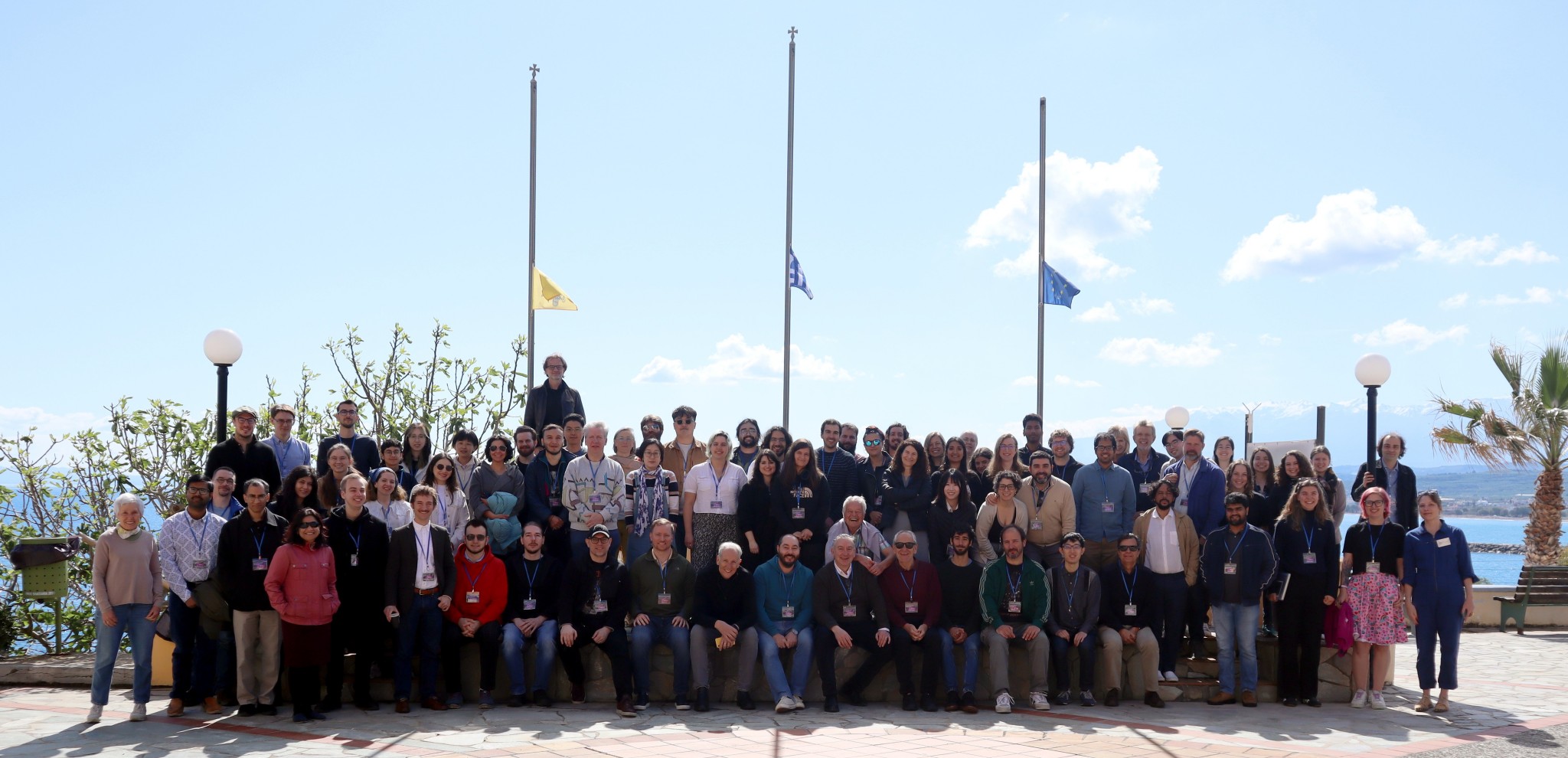| Escape of Lyman
radiation from galactic labyrinths 8-11 April 2025, OAC, Kolymbari, Crete |
 |
Conference program
Abstract booklet
Rationale
The genesis and escape of Lyman alpha and continuum radiation on galactic and subgalactic scales is a result of a complex and subtle interplay between the dynamical constituents of evolving galaxies. Our knowledge on how Lyman radiation produced by massive stars, AGN and shocks is further processed within a galaxy is woefully incomplete.
On subgalactic scales, the pathways of Lyman photons from young stellar clusters and HII regions into the surrounding diffuse ionized gas, and their imprints on the physical properties of the multi-phase ISM are still unclear. On galactic scales, the scattering Odyssey of Lyman-alpha photons from their birthplace out to the galactic halo remains to be written. How feedback processes shape the 3D structure, chemical abundance patterns and kinematics of the gas along this route, and what mechanisms regulate the escape of Lyman radiation out of the galaxy Labyrinth is an unsolved enigma. The escape fraction of Lyman radiation along the co-evolution of AGN with their galaxy hosts is another subject with key astrophysical relevance where our knowledge is still largely incomplete. A final question concerns how escaping Lyman radiation can illuminate the cosmic web and influence the evolution of galaxies across larger cosmic volumes.
The goal of this meeting is to bring observers and theoreticians together toward a joint exploration of the Odyssey of Lyman radiation on its way out of the galaxy Labyrinth.
This conference is motivated by questions such as:
- how are the formation history of galaxies and the evolving physical properties of their multi-phase ISM related to the escape fraction of Lyman-alpha and Lyman-continuum photons?
- how does the escape of Lyman radiation evolve with the rise and fall of star-forming and accretion-powered nuclear activity in galaxies, and what are its imprints on the circumgalactic medium and the cosmic web?
- what modeling concepts and observational constraints are most needed to achieve a breakthrough in our understanding of Lyman photon escape both at subgalactic and galactic scales?
Topics
i. Production of Lyman radiation
ii. Transport of Lyman radiation on subgalactic scales
iii. Lyman photon escape in star-forming galaxies
iv. Current and future observing facilities essential to the understanding of Lyman photon escape
Invited Speakers
Pratika Dayal (University of Groningen, The Netherlands)
Andrea Ferrara (Scuola Normale Superiore, Italy)
Ylva Götberg (Institute of Science and Technology Austria - ISTA)
Andrea Grazian (INAF–Osservatorio Astronomico di Padova, Italy)
Floriane Leclerq (University of Geneva, Switzerland)
Rui Marques-Chaves (University of Geneva, Switzerland)
Sara Mascia (Institute of Science and Technology Austria - ISTA)
Naveen Reddy (University of California, Riverside, USA)
Kanak Saha (Inter-University Centre for Astronomy and Astrophysics, India)
Alison Strom (Northwestern University, USA)
Eros Vanzella (INAF-Osservatorio di Astrofisica e Scienza dello Spazio di Bologna, Italy)
Peter Weilbacher (Leibniz Institute for Astrophysics, Germany)
Scientific Organizing Committee
Ricardo Amorín (IAA-CSIC, Spain)
Jarle Brinchmann (Institute of Astrophysics and Space Sciences, Portugal & European Southern Observatory)
Christopher J. Conselice (University of Manchester, UK)
Sophia Flury (University of Edinburgh, UK)
Matthew Hayes (Stockholm University, Sweden)
Göran Östlin (Stockholm University, Sweden)
Laura Pentericci (Osservatorio Astronomico di Roma, Italy)
Claudia Scarlata (Minnesota Institute for Astrophysics, USA)
Daniel Schaerer (University of Geneva, Switzerland)
Elizabeth Stanway (University of Warwick, UK)
Anne Verhamme (University of Geneva, Switzerland)
José Manuel Vílchez (IAA-CSIC, Spain)
Rogier Windhorst (Arizona State University, USA)
Polychronis Papaderos (Institute of Astrophysics and Space Sciences, Portugal)
Local Organizing Committee
Elsa Silva (Institute of Astrophysics and Space Sciences, Portugal)
Manuel Monteiro (Institute of Astrophysics and Space Sciences, Portugal)
Ioannis Mountogiannakis (OAC, Greece)
Zoe Tsiami (OAC, Greece)
Emmanuela Gerakaki (Ruprecht-Karls-Universität Heidelberg, Germany)
Antonis Kalogerakis (OAC, Greece)
Giorgos Falangaris (OAC, Greece)
Polychronis Papaderos (Institute of Astrophysics and Space Sciences, Portugal)
Code of conduct
| Key
dates |
|
|
Opening
of registration & abstract submission:
|
1 December 2024
|
|
Deadline
for abstract submission:
|
21 January 2025
|
|
Notification
of abstract acceptance for oral and poster
presentations:
|
5 February 2025
|
|
Announcement
of the program:
|
12 February 2025
|
|
Deadline
for regular registration:
|
11 March 2025
|
You can submit your registration here.
For inquires please contact lyman2025@iastro.pt or loc@photonescape.org.
| Previous conferences of this series | 2016 |
2018 |
2023 |